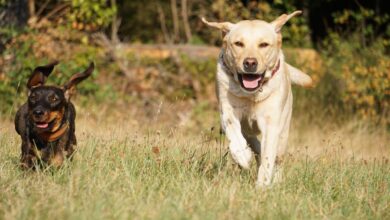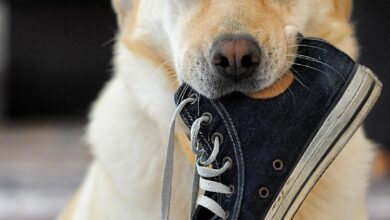
BY BERNADETTE ROBERTS
Labradors and Retrievers, like any breed, can develop behaviour problems, especially if they’re not properly trained, socialized, or mentally stimulated. Understanding the common issues these dogs face can help owners take preventative measures and correct unwanted behaviours. Check out these 10 behaviour problems in Labradors and Retrievers, along with tips on how to address them.
Excessive Chewing
Labradors and Retrievers are notorious for chewing, especially during their puppy years. While chewing is a natural behaviour for dogs, excessive chewing can lead to damaged furniture, shoes, and even dangerous health issues if they ingest inappropriate items.
Solution: Provide appropriate chew toys to satisfy their need to gnaw. Offer different textures and types of toys to keep them engaged. If your dog chews on furniture or other items, gently redirect their attention to a toy. Ensuring they get enough physical and mental stimulation throughout the day also helps reduce the need to chew.
Jumping Up on People
Labradors and Retrievers are affectionate and enthusiastic, which can lead to excessive jumping when greeting people. While this may seem playful, it can be problematic, especially for guests or children.
Solution: Teach your dog an alternative behaviour, such as sitting or staying, when greeting people. Use positive reinforcement, rewarding them with treats and praise when they keep all four paws on the ground. Be consistent with training and avoid reinforcing jumping by not giving attention when they jump.
Pulling on the Leash
Labradors and Retrievers tend to be strong and energetic, and without proper leash training, they may pull on walks, making the experience unpleasant for both the dog and the owner.
Solution: Use positive reinforcement training to encourage loose-leash walking. When your dog pulls, stop walking and wait for them to return to your side before proceeding. Reward them when they walk nicely next to you. You can also try using a front-clip harness, which discourages pulling, or consider enrolling in obedience classes to improve leash manners.
Separation Anxiety
Labradors and Retrievers can become very attached to their owners, and they often experience separation anxiety when left alone. This may lead to destructive behaviours such as chewing, barking, or accidents in the house.
Solution: Gradually desensitize your dog to being alone by starting with short absences and increasing the duration over time. Make sure they have a comfortable and safe space when you’re gone, with plenty of toys and something familiar, like a blanket. You may also want to consider using puzzle toys or a treat-dispensing camera system to keep your dog entertained while you’re away.
Digging
Digging is a common behaviour in Labradors and Retrievers, especially in the yard or garden. Dogs may dig for various reasons, including boredom, attention-seeking, or an instinctual need to create a cool resting place.
Solution: Ensure your dog is getting enough exercise and mental stimulation. You can also create a designated digging area in your yard, like a sand pit, where your dog is allowed to dig. If your dog digs because they are trying to escape or are seeking attention, reinforce positive behaviours and avoid giving attention when they dig.
Resource Guarding
Resource guarding can occur when a Labrador or Retriever becomes possessive over food, toys, or even their owner. This can be dangerous if it leads to growling, snapping, or aggression.
Solution: Practice “trading” games where your dog learns that giving up an item results in receiving something better. Start with low-value items and gradually increase the value. If you notice resource guarding around food, try hand-feeding your dog or using puzzle feeders to make mealtimes more engaging and less competitive.
Excessive Barking
Labradors and Retrievers are not typically barkers, but some may develop excessive barking due to boredom, anxiety, or excitement. This can become a nuisance for both the dog owner and the neighbours.
Solution: Determine the cause of the barking—whether it’s attention-seeking, boredom, or a fear-related issue. Make sure your dog gets plenty of physical and mental stimulation. If barking is triggered by a specific event, such as someone approaching the door, desensitize your dog by gradually exposing them to that stimulus while rewarding calm behaviour. Use commands like “quiet” and reward them when they stop barking.
Lack of Recall (Coming When Called)
A Labrador or Retriever with a poor recall can be a safety risk, as they may run off or ignore commands when called, especially in open areas or when distracted by other animals.
Solution: Start recall training in a controlled environment, such as a fenced yard, using high value treats to encourage your dog to come to you. Gradually increase the level of distraction and distance. Always reward immediately when they respond correctly. Avoid punishing your dog when they fail to come, as this can make them associate recall with negative consequences.
Destructive Behaviour Due to Boredom
Labradors and Retrievers are high-energy dogs that require plenty of stimulation. When they don’t get enough physical or mental exercise, they may resort to destructive behaviours like chewing, digging, or knocking things over.
Solution: Ensure your dog has a daily exercise routine that includes both physical activity and mental challenges. Take them on long walks, runs, or hikes, and provide puzzle toys or obedience training to keep their minds engaged. Regular playtime with interactive toys or games like fetch can also help burn off excess energy.
Hyperactivity and Over-Excitability
Labradors and Retrievers can sometimes become overly excitable, especially in new environments or around unfamiliar people or animals. This can lead to jumping, barking, or difficulty settling down.
Solution: Provide consistent training and structure for your dog. Teach them calm behaviours, such as sitting or lying down, when they get too excited. Use positive reinforcement to reward calm behaviour and gradually increase their ability to stay relaxed in stimulating situations. Also, ensure they get enough exercise to reduce pent-up energy.
Labradors and Retrievers are generally well-behaved and loving companions, but like all dogs, they can develop behaviour problems if not given the right environment, training, and attention. By understanding these common issues and providing the appropriate solutions, owners can ensure their Labrador or Retriever leads a happy, healthy, and well-behaved life. Consistency in training, mental stimulation, and physical exercise is key to addressing behaviour problems and helping these dogs thrive as wonderful family pets.






